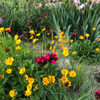Dianthus cruentus - BLOOD CARNATION
Slender, eye-catching flower with vivid carmine red flowers. Gray-green grassy leaves (semi-evergreen), leafless stems.
Not a super long-lived plant, lives about 3-4 years, but seems to be easy to grow in garden conditions. Can self-seed in good conditions, but we haven't observed it really. Does surprisingly well in our hot and humid climate.
For sunny garden and drained soils.
Blooming Time: usually throughout May to early June.
Size: 1.5-2' tall tall x 0.75' wide, airy structure, leaves stay only at the base, clusters of flowers way above the foliage
USDA Zones: 5-8
Culture: sun, half sun, prefers drained to well drained soil with average moisture (medium) to medium-dry and dry soil. Average, sandy, rocky, gritty soils. Avoid waterlogged soils! Very drought tolerant. Avoid heavy mulching with organic material - can cause crown rot.
Moisture Needs: medium (average), medium-dry to dry. We do grow it quite successfully on a bit heavier soils, that were amended with coarse sand.
Origin: Native to the Balkan Region of southeastern Europe
Deer/Rabbit Resistant: yes / rabbits occasionally nibble on this plant, but don't destroy it
Attracts Butterflies or Pollinators: yes / yes, pollinator friendly, but not pollinator magnet
Attracts Hummingbirds: possibly yes
Pot Size:square 3.5" x 4" deep perennial pot
Plant Combinations: Flower beds with drier or drained soil, rock garden, bigger crevice gardens, xeriscape. Good with Echinacea, Achillea, Agastache, Amsonia, summer blooming Allium, Asclepias tuberosa, Aster, Baptisia, Calamintha, Coreopsis, Gaura, Knautia, Liatris, Monarda, Nepeta, Oenothera, Penstemons, Platycodon, Pycnanthemu tenuifolium, smaller Rudbeckia, Salvia nemorosa hybrids, tall Sedum, Solidago, Stachys, Vernonia lettermannii, taller Veronica, Yucca, and grasses like Bouteloa, Muhlenbergia, Sporobolus, Schizachyrium scoparium, Sorghastrum or shorter Panicum.
Picture Copyright: US Perennials

Dianthus cruentus - BLOOD CARNATION
Slender, eye-catching flower with vivid carmine red flowers. Gray-green grassy leaves (semi-evergreen), leafless stems.
Not a super long-lived plant, lives about 3-4 years, but seems to be easy to grow in garden conditions. Can self-seed in good conditions, but we haven't observed it really. Does surprisingly well in our hot and humid climate.
For sunny garden and drained soils.
Blooming Time: usually throughout May to early June.
Size: 1.5-2' tall tall x 0.75' wide, airy structure, leaves stay only at the base, clusters of flowers way above the foliage
USDA Zones: 5-8
Culture: sun, half sun, prefers drained to well drained soil with average moisture (medium) to medium-dry and dry soil. Average, sandy, rocky, gritty soils. Avoid waterlogged soils! Very drought tolerant. Avoid heavy mulching with organic material - can cause crown rot.
Moisture Needs: medium (average), medium-dry to dry. We do grow it quite successfully on a bit heavier soils, that were amended with coarse sand.
Origin: Native to the Balkan Region of southeastern Europe
Deer/Rabbit Resistant: yes / rabbits occasionally nibble on this plant, but don't destroy it
Attracts Butterflies or Pollinators: yes / yes, pollinator friendly, but not pollinator magnet
Attracts Hummingbirds: possibly yes
Pot Size:square 3.5" x 4" deep perennial pot
Plant Combinations: Flower beds with drier or drained soil, rock garden, bigger crevice gardens, xeriscape. Good with Echinacea, Achillea, Agastache, Amsonia, summer blooming Allium, Asclepias tuberosa, Aster, Baptisia, Calamintha, Coreopsis, Gaura, Knautia, Liatris, Monarda, Nepeta, Oenothera, Penstemons, Platycodon, Pycnanthemu tenuifolium, smaller Rudbeckia, Salvia nemorosa hybrids, tall Sedum, Solidago, Stachys, Vernonia lettermannii, taller Veronica, Yucca, and grasses like Bouteloa, Muhlenbergia, Sporobolus, Schizachyrium scoparium, Sorghastrum or shorter Panicum.
Picture Copyright: US Perennials


